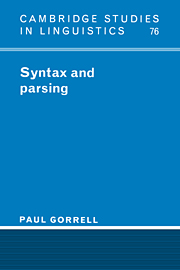6 - Conclusion
Published online by Cambridge University Press: 30 March 2010
Summary
Again, one thinks of Don Quixote. He may see a windmill as a giant, but he doesn't see a giant unless there is a windmill there.
W. H. AudenIn this book I have outlined a theory of syntactic knowledge and examined its role in language comprehension. Although I have argued that syntax plays a significant role in perception, it is clearly the case that numerous other factors also play a role. For example, there are currently underway a number of important studies within the general framework of constraintbased comprehension systems. As briefly discussed in the last chapter, it is important that theories of syntactic processing incorporate, in some way, the effects of frequency of both individual lexical items as well as cooccurrence probabilities (MacDonald 1994, Trueswell et al. 1993). I have not attempted to do that here. Rather the focus has been to establish the role of structural variables in sentence processing.
One of the most important aspects of the parsing model proposed here is the grammatical distinction between primary and secondary structural relations in a phrase-structure tree. This distinction is reflected in the design of the processing model, given in (1). The types of syntactic relations which a GB-based parser must encode in the structural representation it builds are listed in (2).
- Type
- Chapter
- Information
- Syntax and Parsing , pp. 163 - 166Publisher: Cambridge University PressPrint publication year: 1995



